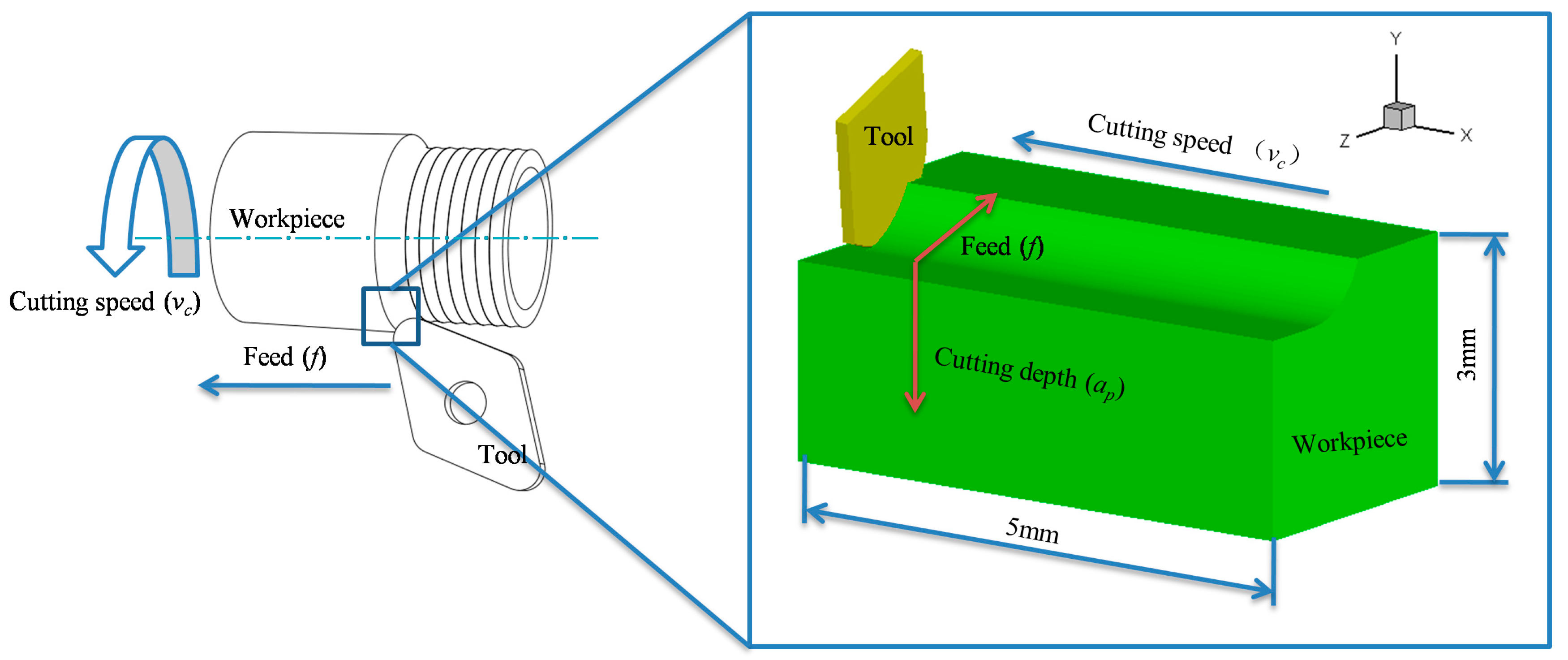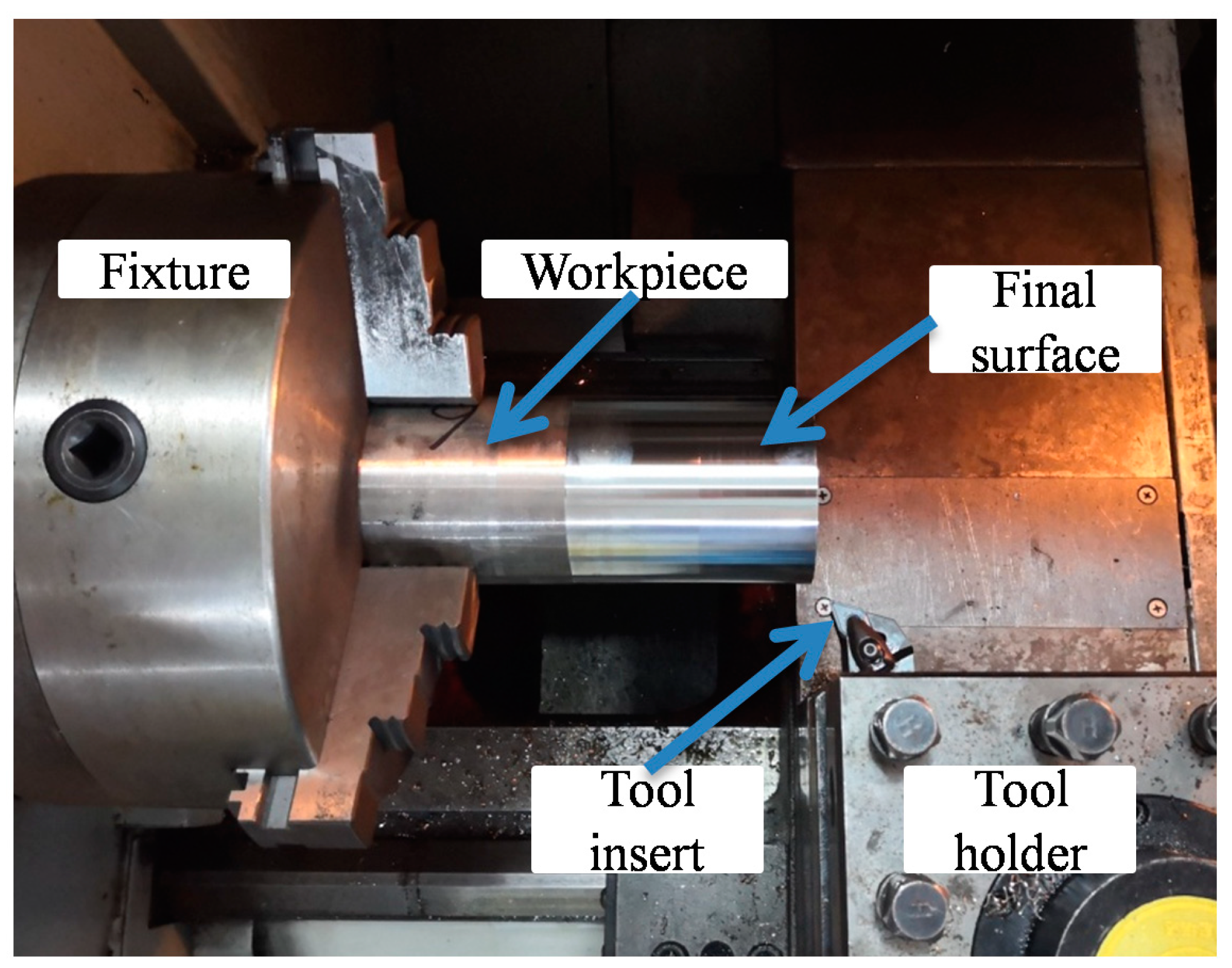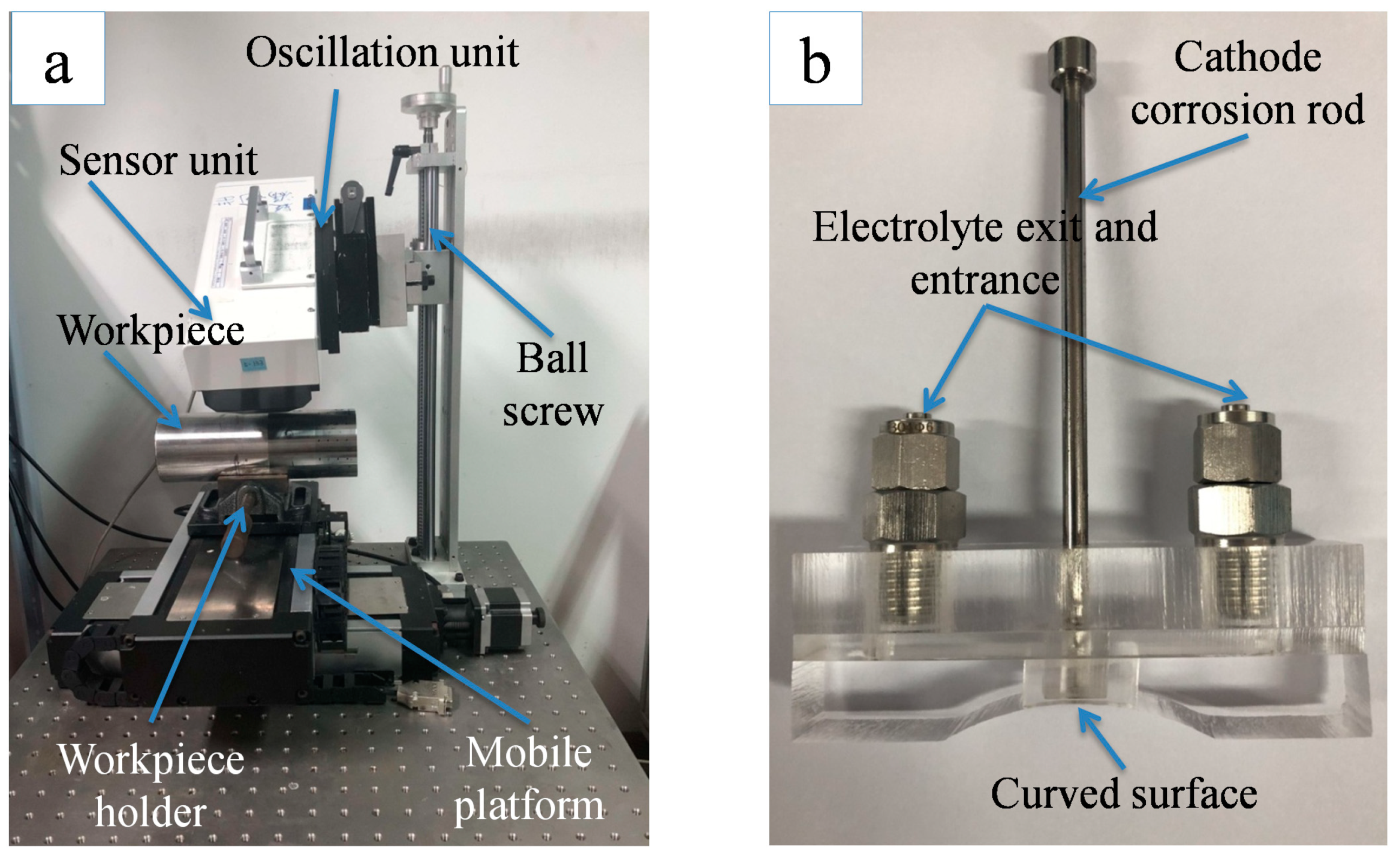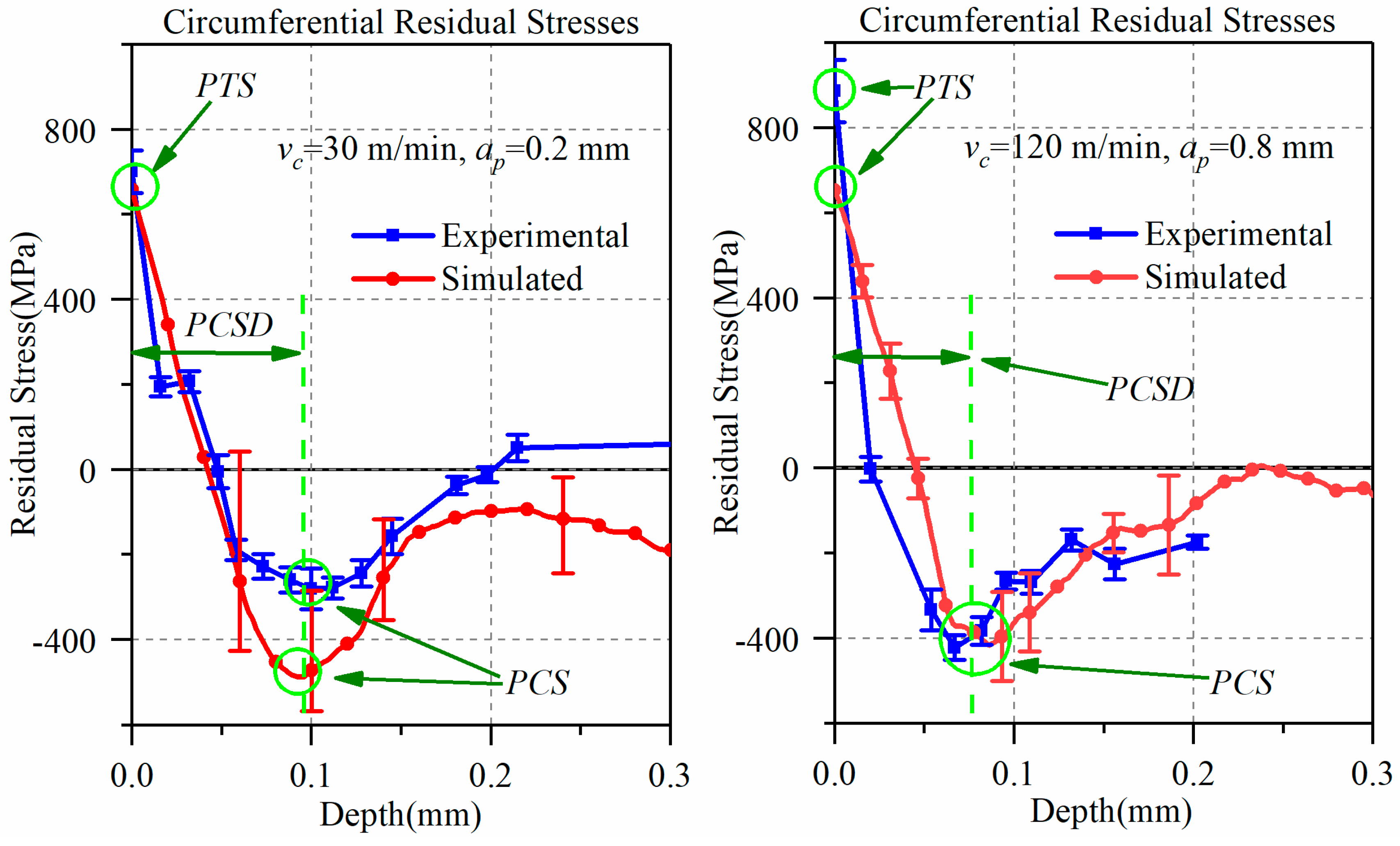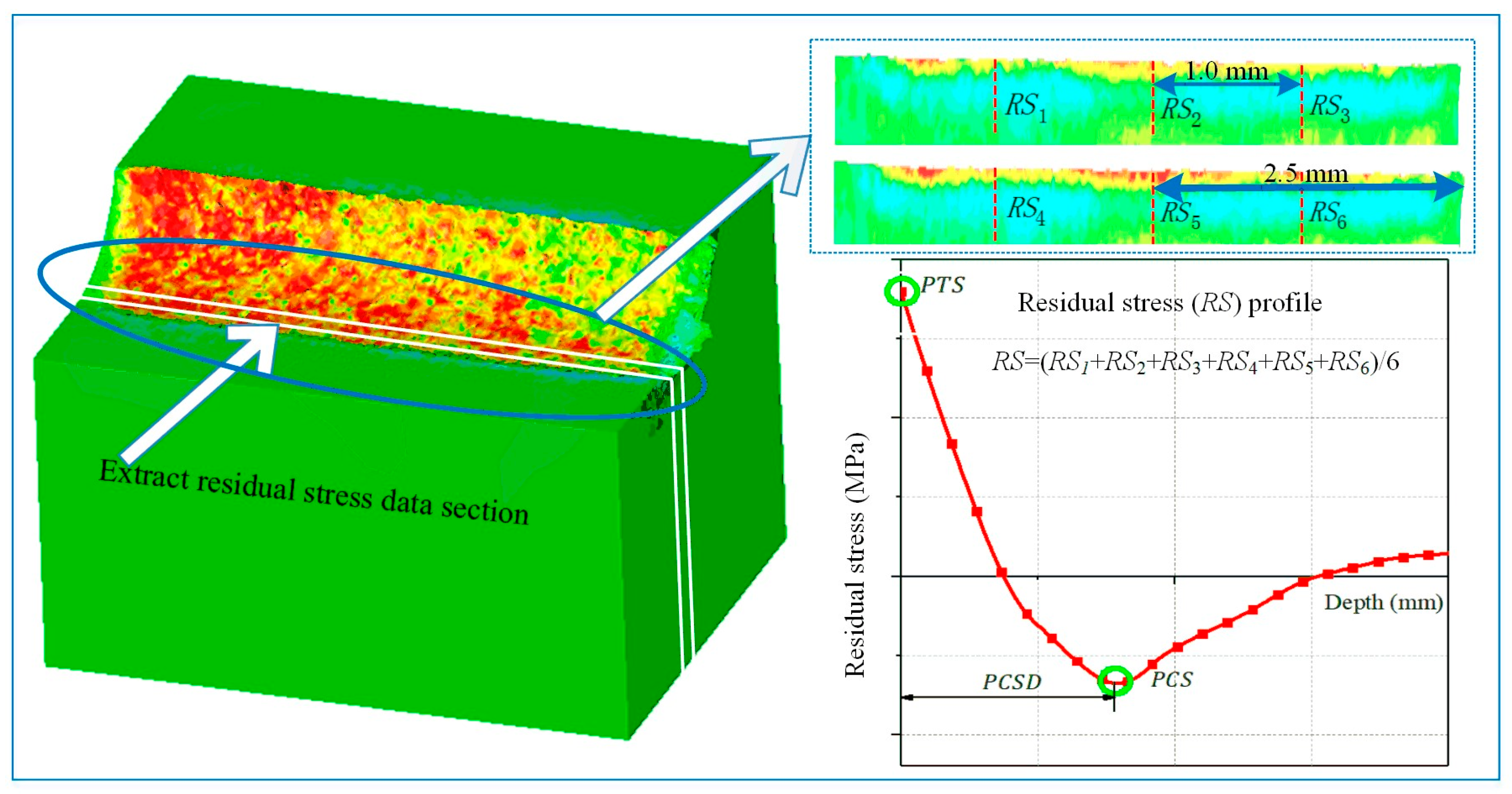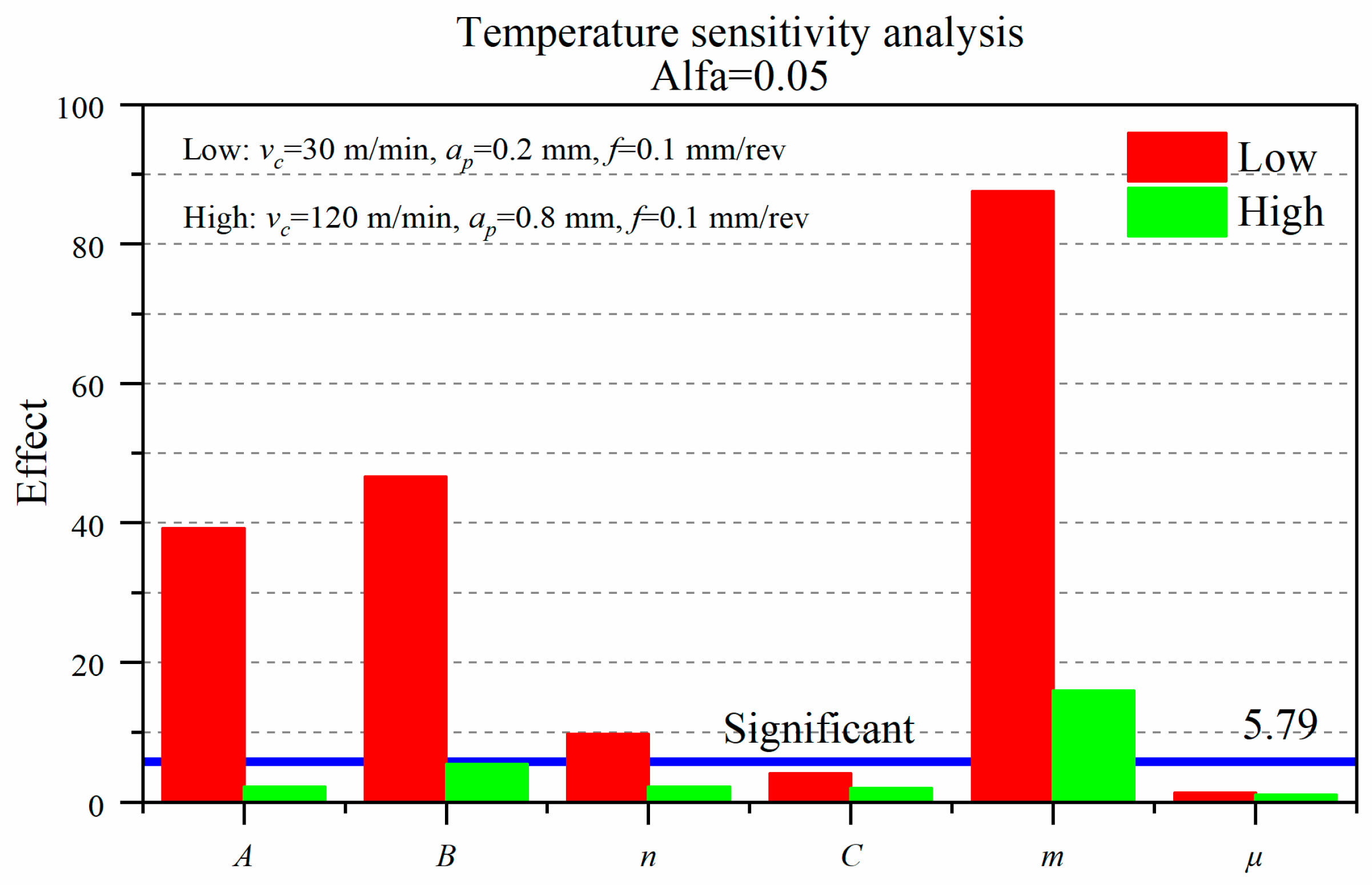1. Introduction
Nickel-based alloys, especially Inconel 718, are preferred materials for critical components in the industrial field due to stability at high temperatures [
1]. The finite element model appears to be a useful solution to study the cutting phenomenon, owing to the expensive and challenging processing of Inconel 718. The Johnson-Cook (J-C) constitutive model and tool-to-chip friction coefficient are two kinds of critical data for machining simulation, which are necessary conditions for accurate prediction of the machining process.
In recent years, a variety of constitutive models have been proposed to describe the metal cutting process, some of which were improved [
2] to more accurately depict the plastic strain of unique materials. As the J-C constitutive model’s [
3] characteristics are accurate and straightforward, it is generally integrated into commercial finite element software [
4].
Equation (1) contains five parameters [
5], namely the yield strength,
A, the strain hardening coefficient,
B, the strain hardening exponent,
n, the strain rate hardening coefficient,
C, and the thermal softening coefficient,
m. Besides,
,
, and
are the strain, the strain rate and the reference strain rate respectively, and
T,
Tmelt, and
Troom orderly represent the temperature, the melting temperature and the room temperature.
In the literature, the same material has multiple sets of J-C parameters, which is not conducive to select appropriate J-C values [
6]. For Inconel 718, dozens of J-C constants can be found because of different element compositions and heat treatment conditions, consequently, the stress-strain curves vary widely. Therefore, it is necessary to establish a method to identify applicable J-C values [
7]. Acquiring the influence of five parameters in the J-C constitutive model on simulation results, it can guide people to choose the proper values. In this context, some researches are related.
From the results of Umbrello et al. [
8], it could be qualitatively concluded that J-C parameters have a significant influence on the residual stress, chip shape, cutting force, and temperature distribution. However, further study needs to be done to investigate how J-C parameters affect the simulation results and to determine which parameters are significant factors.
Kortabarria et al. [
9] identified that the coefficients
B and
m have a prominent effect on the residual stress profile. Nevertheless, the increments for four parameters between the selected two levels of the J-C constitutive model were different (
A: 12%,
B: 83%,
n: 39%,
m: 77%). Better controlling the increment level could make the study more convincing. When the five coefficients change in the same percentage level, the effects of coefficient
B and
m on the residual stress seem to alter. So far, the research on Inconel 718 mostly concentrates on relatively low cutting conditions. For Inconel 718 alloy, when the cutting speed exceeds 50 m/min, it belongs to high-speed machining [
10]. At high-speed cutting conditions, the research on Inconel 718 is mostly about chip deformation, instead of the residual stress. As high-speed machining is paid more attention, the effect of high-speed machining should be explored.
The friction between the workpiece and tool has an important influence on the plasticity deformation of materials [
11], and undoubtedly, it is important to affect the finite element model simulation result. Komvopoulos [
12] first used the average Coulomb friction coefficient to simulate the relationship between the friction coefficient and the residual stress distribution. In the present research, the friction coefficient was determined by empirically fixed values or trial calculation. In the literature, the Coulomb friction coefficient of Inconel 718 is set in a large range, such as 0.23 [
9], 0.5 [
2], and 1.0 [
13]. Therefore, the effect of the friction coefficient on the simulation is also worth analyzing to determine the appropriate friction coefficient and control the simulation results.
From the literature review, it can be concluded that the topics of the J-C constitutive model and the friction coefficient have been thoroughly investigated so far. The content of the research mostly focuses on the J-C model and friction factor qualitatively, which is not conducive to the selection and adjustment of J-C parameters. There are only a few articles that try to find out which parameters have a significant effect and generally consider cutting parameters located at relatively low conditions. The full application of high-speed machining makes this problem more evident and essential. It is worthwhile to study the different influence of the J-C constitutive model and friction coefficient on machining results at high cutting conditions. Besides, no study has mixed the J-C constitutive model and the friction coefficient, comparing the significance of the six coefficients. These two preprocessed data are the key factors affecting the accuracy of the simulation.
This paper aims to investigate the influence difference of five parameters in the J-C constitutive model and friction coefficient on machining-induced residual stresses, chip morphology, cutting force and temperature of turning Inconel 718 at the low-high cutting conditions with the hybrid orthogonal test. The finite element model was first verified by comparing the residual stress and chip thickness of the experimental and simulation results. Then, under the low-high cutting conditions, carrying out a 3-level 6-factors hybrid orthogonal test, the sensitivity study results were acquired by analysis of variance (ANOVA) at a 95% confidence level, which can provide direction for adjusting simulation results.
3. Results and Discussion
The test plan and results are shown in
Table 8 and
Table 9. The sensitivity analysis were obtained by ANOVA and calculated with Equation (2):
where,
Fj is the statistic of test sensitivity, reflecting the degree of influence of each factor’s change on the index,
Sj is the sum of squared differences of the factors,
Se is the sum of squared changes of error,
fj is the degree of freedom of each factor, and
fe is the degree of freedom of test error.
The sensitivity analysis of each factor to the simulation results is acquired by the value of Fj in Equation (2). The test level confidence α = 0.05, and the F distribution table shows that F0.05(2,5) = 5.79. The Fj of each factor is compared to 5.79 to determine the significance level. The criterion is: when Fj > F0.05(2,5), the factor has a significant influence and high sensitivity, when Fj < F0.05(2,5), the factor has no significant effect and low sensitivity.
3.1. Force and Temperature
Figure 7 shows the effect of J-C parameters and friction coefficient on the three directions of the average machining force in two cutting conditions. Under the low-high cutting parameters, the coefficients that have a significant influence on the cutting force are the yield strength,
A, the thermal softening coefficient,
m, the friction coefficient,
μ, the strain hardening coefficient,
B, and the strain hardening exponent,
n. The effects of
A and
m are the most considerable among six coefficients, and the strain rate hardening coefficient,
C, has the least influence and is not significant.
The coefficient A markedly affects the tangential force (Fc), the axial force (Ff), and the radial force (Fr). The coefficient m shows greater influence on the tangential force (Fc) than the axial force (Ff) and the radial force (Fr), but the coefficients B and n only have a little significant effect on the tangential force. As the cutting conditions increase, the influence of the friction coefficient (μ) on the cutting force gradually becomes significant.
In addition, at different cutting conditions, the influence degree of A and m parameters on cutting force are different. At the low cutting condition, A is larger than m. Nevertheless, under high cutting conditions, the maximum reduction degree of A on cutting force is 88%, and the influence degree of m on the tangential force is increased by 81% compared with the low cutting condition. Consequently, the influence of A and m on the tangential force tends to be close. It can be confirmed that as the cutting parameters increase, the Inconel 718 material is more sensitive to the effects of thermal softening.
For the cutting force, the coefficients that have an essential influence are
A, m, μ, B, and
n, where
A and
m have the most significant effects, which also happened in the research result of Wang et al. [
19], who employed a cutting speed (
vc) of 500 m/min, and a depth of cut (
ap) of 0.1 mm. The degree of influence of
A and
m on the cutting force are very disparate at low-high cutting conditions, and the friction coefficient (
μ) only becomes significant to cutting forces at the high cutting condition. The literature [
20] also mentioned that the friction coefficient should be paid attention at higher cutting conditions.
Figure 8 presents the effects of J-C parameters and friction coefficient on the final surface average temperature (
Tmax) at two cutting conditions. The factors whose influence degree from high to low at the low cutting parameter respectively are the thermal softening coefficient
m, the strain hardening coefficient
B, the yield strength
A, and the strain hardening exponent
n. The strain rate hardening coefficient
C and the friction coefficient
μ are less than 5.79 and not significant. In the high cutting condition, the influence of the six coefficients on the temperature is generally reduced, and the minimum reduction of effect degree in the coefficient
m is 82% because of the heat carried by the chip principally and a fraction of heat change of the introduced workpiece. Only the coefficients
B and
m are significant to the temperature, and the influence degree of the coefficient
m is still greater than
B.
3.2. Residual Stress
Figure 9 provides the effect of J-C parameters and friction coefficient on predicted residual stress at low-high cutting conditions. The peak tensile stress (PTS) and the depth of the peak compressive stress (PCSD) are susceptible to J-C parameters. Nevertheless, no significant coefficient was obtained to the peak compressive stress (PCS). The coefficients that both have a crucial influence on residual stress under the two sets of cutting parameters are the yield strength
A and the thermal softening coefficient
m. The coefficient
n only appears to have a strong influence in the high cutting condition, and the effect of the rest of the three coefficients are less than 5.79 and not significant.
Furthermore, the principal influence coefficients are different in the low-high cutting conditions. At the low cutting condition (vc = 30 m/min, ap = 0.2 mm), the peak tensile stress (PTS) is mainly affected by the parameters A and m, where the influence of A is slightly greater than m. The depth of the peak compressive stress (PCSD) is significantly affected by A. Under the high cutting condition (vc = 120 m/min, ap = 0.8 mm), the coefficients of A, n, and m have an important influence on the peak tensile stress (PTS), where the influence degree of m is more prominent than A and n. Compared with the low cutting condition, the influence factor of coefficient A decreases by 29.5%, and the influence factor of coefficient m increases by 153%. The coefficient A still has a significant impact on the depth of the peak compressive stress (PCSD), and the influence degree is higher than that of the low cutting condition by 44%.
The reason why the coefficients
A and
m have an essential effect on the peak tensile stress (PTS) is that the surface stress is mainly affected by the mechanical and thermal load [
21]. It can be seen that the coefficients
A and
m similarly have a remarkable influence on the cutting force and heat from
Figure 7 and
Figure 8. When the coefficients
A and
m are increased, the energy needed for material deformation increases, in consequence, the cutting force increased, and heat generation of the processing region increased. Surface tensile stress drastically changes under the effect of both the mechanical and thermal load. On account of the lower thermal conductivity of Inconel 718, cutting heat is mainly concentrated on the final surface. Therefore, the residual stress of the subsurface is primarily affected by the cutting force, resulting in the consequence that coefficient
A appears important influence on the peak compressive stress (PCSD).
In order to better understand the influence of mechanical and thermal load on residual surface stress, the effects of tangential force (
Fc) and temperature (
Tmax) are accumulated under low-high cutting parameters.
Figure 10 shows that the coefficient
A has a larger influence on the superposition than
m in the low cutting condition, although the effect of the coefficient
A on temperature is obviously less than
m. Hence, the accuracy of the yield strength
A should be paid attention first, followed by the thermal softening coefficient
m, with cutting simulations performed at the low cutting condition. It is necessary to execute a tensile test on the Inconel 718 alloy to obtain accurate yield strength before simulation. In the high cutting condition, the influence of the superposition is reversed. The influence of coefficients
A and
m on the tangential force is close. The reason why
m has a significant influence on the maximum tensile stress (PTS) is that the effect of
m on temperature is much higher than
A. Therefore, the accuracy of the thermal softening coefficient
m should be firstly focused on, followed by the yield strength
A, when cutting simulations are performed under the high cutting condition.
The superimposed influence of J-C parameters on tangential force and the temperature is consistent with the trend of peak tensile stress (PTS), indicating that the peak tensile stress (PTS) in the direction of cutting speed is mainly affected by the tangential force and cutting heat. Furthermore, low and high cutting conditions are mostly affected by mechanical loads and thermal loads, respectively.
For the residual stress, after adjusting the difference of variable factors to equal (±20%), compared with the research [
9], the influence degree of coefficient
A increases prodigiously, the influence factor of coefficient
B drops to no significance, and the coefficient
m still has a prominent effect on the residual stress profile. The influence degree will visibly change at different cutting parameters.
3.3. Chip
Figure 11 displays the sensitivity analysis of J-C parameters and friction coefficient to average chip thickness (
h) under low-high cutting conditions. The results present that the chip thickness (
h) is mainly affected by the yield strength
A, strain hardening exponent
n and the thermal softening coefficient
m. The influence of the rest of the three coefficients on the chip thickness (
h) are all less than 5.79 and not significant. Under the high cutting conditions, the three coefficients
A,
n, and
m have the same influence tendency on the chip thickness (
h) as in the case of under the low cutting condition. The influence degree of
A is much larger than
n, and
n is slightly larger than
m.
The chip thickness is related to the chip deformation coefficient (
λh), and the degree of deformation is principally affected by the shear slip and the extrusion and friction of the rake face. The deformation coefficient (
λh) can be calculated with Equation (3):
where,
h is the chip thickness, and
hD is the uncut chip thickness (equal to the feed (
f)).
Comparing
Figure 7,
Figure 8 and
Figure 11, the effect of the coefficients
A and
m on the chip thickness are consistent with the trend of the radial force (
Fr). The cutting force affects the change of the shear angle, which affects the deformation coefficient (
λh). As a consequence, the chip thickness is affected. The mechanism to explain the effect of the exponent
n on the chip thickness seems to be more complicated since the impact of the coefficient
n on the cutting force and temperature is not very significant. It needs to be further researched to comprehend this phenomenon. The coefficient
n is consistent with the result of Ti6Al4V material in Ducobu et al. [
6].
In the high cutting condition, the influence factor of A is 53% lower than that in the low cutting condition. This is coincident with the influence tendency of J-C parameters on the radial force (Fr). On the one hand, this content reveals that the variation of chip thickness is mainly affected by the radial force (Fr). On the other hand, this effect is greatly weakened under high cutting conditions, and the influence on the radial force (Fr) is also reduced. Under this machining condition, because the deformation coefficient (λh) of the chip generally increases, and the percentage of the heat generated by the plastic deformation increases, the Inconel 718 alloy is more sensitive to the effect of the heat softening in the high cutting condition.
At the 95% confidence level, the friction coefficient (μ) universally has a lower effect on the cutting force and temperature. Therefore, it does not obviously affect residual stress and chip deformation. It is worth noting that the effect difference is close when concentrating on peak tensile stress (PTS), peak compressive stress (PCS), and chip thickness under low and high machining conditions. The disturbance from the friction coefficient is slightly affected by the cutting parameters, except the depth of the peak compressive stress (PCSD). It is well illustrated that the simulation results are mainly affected by the workpiece material (J-C) and the cutting parameters, rather than the friction coefficient.
